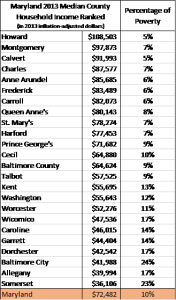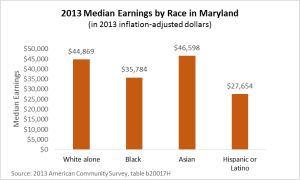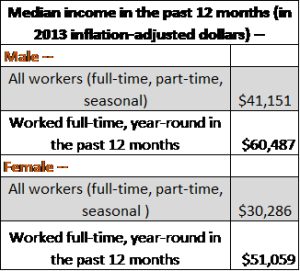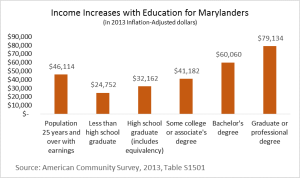State of Working Maryland: A tale of two Marylands
Despite its overall wealth, Maryland continues to be plagued by wide inequities in income and opportunity. How successful you are can depend on where you live, how educated you are, the color of your skin, and if you are a man or a woman.
Legislators and the governor speak often about improving life in Maryland, but we need to carefully examine who benefits from their proposals. Maryland is home to two vastly different groups of people—the very rich and the very poor. We need policies that support growing our economy to help all Marylanders, not just those at the top.
 Wages for the working class have been stangant for some time. In fact, Marylander’s incomes fell between 2009 and 2013. And the gap between the higher-incomes and lower-incomes widened, a trend that has yet to be reversed and stifles opportunity for those at the lower end of the income spectrum.[1] Maryland’s wages for the lowest earners — those who work in service jobs, like childcare workers and personal aides — have seen almost zero wage growth since 2007.[2] Maryland did raise the minimum wage last year, but by the time it is fully implemented the benefit will be smaller than anticipated. We already ask those who make the least to pay a greater share of their income in taxes than those who are better off, and the proposed cuts to Maryland’s budget would harm investments in what has made Maryland great, such as our schools.
Wages for the working class have been stangant for some time. In fact, Marylander’s incomes fell between 2009 and 2013. And the gap between the higher-incomes and lower-incomes widened, a trend that has yet to be reversed and stifles opportunity for those at the lower end of the income spectrum.[1] Maryland’s wages for the lowest earners — those who work in service jobs, like childcare workers and personal aides — have seen almost zero wage growth since 2007.[2] Maryland did raise the minimum wage last year, but by the time it is fully implemented the benefit will be smaller than anticipated. We already ask those who make the least to pay a greater share of their income in taxes than those who are better off, and the proposed cuts to Maryland’s budget would harm investments in what has made Maryland great, such as our schools.
Maryland consistently has a high median household income compared to other states. However, at least 1 in 10 Marylanders doesn’t have enough to make ends meet. So while there are many who are prospering, there are many who are struggling. Families’ expenses have not decreased because their wages have. Instead, they are having to make do with less and turn to supports like the Supplemental Nutrition Assistance Program to help pay for basic necessities.
Furthermore, while the state as a whole has a high median income many counties tell a different story. The disparity between counties are often e large. For example, Howard County’s median income of $108,503 is much higher than neighboring Baltimore County’s $64,624. Some areas of the state have even lower median incomes; Somerset County is last at just $36,106. When we look at where people are experiencing poverty, it is no surprise that areas with lower median household incomes also have higher rates of poverty. Prosperity should not be dependent on where you live in Maryland,  it should be accessible to everyone.
it should be accessible to everyone.
Variation in income by location is not the only place where income disparities exist. For example, median household incomes by race and sex also reveal two different stories. Whites in Maryland are least likely to live in poverty, while blacks are most likely. We need policies from our elected officials that will help all Marylanders get a job that pays them enough to support their families.
 Differences in wages by sex are smaller in Maryland than the nation, but women still earn less than men. Women in Maryland earn, on average, 85 cents for every dollar earned by a man. Beyond the inequality that this promotes between men and women, in Maryland 1 in 5 households are female headed, which means that these families have an even more difficult time trying to survive.
Differences in wages by sex are smaller in Maryland than the nation, but women still earn less than men. Women in Maryland earn, on average, 85 cents for every dollar earned by a man. Beyond the inequality that this promotes between men and women, in Maryland 1 in 5 households are female headed, which means that these families have an even more difficult time trying to survive.
Education as a path out of poverty
Education is one way to increase income. The more education an individual has, the higher their earnings. Although those with college degrees and those without have both seen stagnant wages, college graduates fared somewhat better. One of Maryland’s strengths is its highly educated workforce. The state needs to continue investing in educational opportunities that include more Marylanders, like universal pre-k and affordable higher education.
This legislative session, Maryland lawmakers have proposed an equal wage for equal work bill (Senate Bill 424/House Bill 1051). If passed, the bill would prohibit an employer from firing, demoting or otherwise punishing an employee for the disclosure or discussion of an employee’s wages. This is an important first step to correcting the inequality of pay between men and women. Employees need to be able to speak about their pay without fear of retaliation by their employers. This proposal would be a significant step forward in correcting a long-standing injustice.
Maryland is a great state for some, but not all. Our spending priorities and other policies need to reflect the type of Maryland we want to grow, a Maryland where all people have the opportunity to earn and support their families. Investments in education, growing businesses that pay a living wage, and healthy communities should be top priorities for Maryland’s elected officials.
Today’s blog post is the third in our State of Working Maryland series looking at demographic and economic trends in the state. Previously, this has been an annual publication. This year we will instead publish occasional blogs and research briefs on topics affecting working families in Maryland.
[1] 2013 American Community Survey, table CPO3
[2] MDCEP analysis of Bureau of Labor Statistics data, State Occupational Employment and Wage Estimates 2007 and 2014 http://www.bls.gov/oes/2007/may/oes_md.htm#b35-0000

